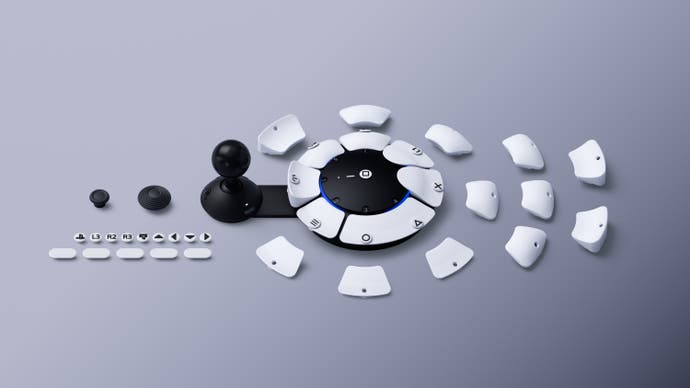The PlayStation Access Controller Review - software's the star, but you'll probably still need a DualSense
Sony's first accessibility controller has a lot of great features, and a few crucial shortcomings.
The PlayStation Access Controller is a bold statement by PlayStation that the platform holder understands the importance of hardware accessibility. Players previously excluded from enjoying PlayStation games due to the lack of hardware choice now have the freedom to expand their gaming horizons.
It's important to note upfront that, while the Access Controller may have similarities to the Xbox Adaptive Controller, it's designed to be a full controller solution without needing external input devices. It's supported by robust accessibility software, rather than acting as a switch hub, like the XAC. There are positives and negatives to this.
The controller itself is aesthetically pleasing, matching the white and black colour scheme of the PS5 and DualSense controller. The rubber grips on the base are a firm foundation to ensure stability when the device is placed on a table or a wheelchair tray, and it also has four attachment points for different wheelchair mounting solutions. The plastic feels durable, surviving a drop test on both carpeted and wooden floor - and it's certainly going to be dropped on occasions if it rests on a knee. Buttons have a satisfying tactile click, making sure you feel and hear a click without glancing down at the controller. The circular design fits perfectly in your hand allowing you to reach the eight buttons, and the sticks can also retract and extend by holding the lock button.
Aside from the controller, the box contains multiple button caps, a flatter cap, a pillow cap, a raised edge cap and a double-length cap to join two buttons together. Detaching the caps is a simple and easy process: you press a low-resistance button in order to remove a latch, and there are magnets to help guide new caps into position. There are three types of sticks which are also easy to change, and the arcade-style stick is great for gamers who prefer to grip the stick with their hands. The choice of attachments is thoughtfully designed to provide enough options for experimentation and guidance. Even early on there is one fundamental barrier with the Access Controller, however, which is the lack of options for changing the resistance of buttons. It will be a struggle for gamers who lack the physical strength to press regular resistance buttons.
The Access Controller aims to be a full controller solution without the requirement for external switches, and it does achieve that purpose for many disabled gamers who will pair it with a DualSense. However, a single Access Controller doesn't feature enough buttons or sticks to fully replace the functionality of a DualSense controller. Instead there are workaround options. You can get creative by pairing an Access Controller with a second Access Controller, a DualSense, or both as part of their accessible gaming ecosystem. If you cannot use a DualSense controller, then you will have to purchase a second Access Controller to create a full controller setup with sixteen buttons. Buying a pair of Access Controllers will cost nearly £160, which is a hefty price for a full controller.
The Access Controller features four 3.5mm ports (eight in a pair) in comparison to the 20 ports on the Xbox Adaptive Controller. The limited number of ports for external peripherals is a barrier to customisation, especially if you require eight external switches or stick inputs. As such, the device's design is going to alienate anyone whose needs vary too much from the controller's core features, which is a huge shame.
The PlayStation Access Controller as a unit is a great accessibility package with some clever design features, but the accessibility software is where the magic happens. Players have complete control over button customisation, and every single input is free to showcase your abilities rather than highlight your limitations.
The Access Controller configuration wizard is simple and easy to follow. It guides you through mapping button functions, setting controller orientation, adjusting stick sensitivity and adding a second Access Controller. This process doesn't provide much guidance on how to lay out your button configuration, thus allowing the player the choice to create a custom controller profile that feels comfortable to them. I suspect your first few hours will consist of experimentation with different layouts until you find the one that works for you. During gameplay, tweaking your setup can be done quickly and easily with a short hold of the controller's profile button, which sends you back to the setup wizard.
Players can set any button to act as a toggle, switching between held and upheld positions, which is perfect for actions that require a button hold and perfect for games that lack an option for toggles. Players can also map two simultaneous controller inputs to a single button, which is useful for titles like Marvel's Spider-Man 2, which has a vast number of simultaneous presses, or to activate Rage Mode in God Of War Ragnarok. Game developers should take notice and include these advanced button-remapping features in future titles.
The controller supports storage for up to three custom controller profiles, which can be easily cycled through during gameplay by pressing the profile button. I've found that I usually stick to a single profile which I tweak depending on which genre of game I'm playing or the importance of certain buttons with actions I know I'll be using most. It may be useful for gamers who require a one-handed controller: by storing a pair of control schemes, players can toggle a single stick between left and right stick functions. This type of experimentation is at the core of the PlayStation Access Controller, and again, the software itself is the reason why it is an innovative device that stands apart from the Xbox Adaptive Controller.
Having spent time with the device, I feel that the biggest limitation with the Access Controller is the heavy reliance on the DualSense controller, which was already the major barrier blocking disabled players from gaming on the PS5. The Access Controller doesn't natively support haptics or the touchpad, and this forces gamers to use a DualSense controller to access these elements. This means that the Access Controller will have limited functionality for those gamers who cannot use a DualSense or incorporate it into their setup. Even if you use two Access Controllers, you still require a DualSense to access the touchpad for swiping. If games such as God Of War Ragnarok assign accessibility shortcuts to directional touchpad swiping, then the Access Controller is actually blocking vital in-game accessibility support. If you cannot move your arms, then swapping between two Access Controllers and the DualSense linked through co-pilot is impossible without physical support. Thankfully, it's easy to instruct people which button needs to be pressed without having to disturb your setup or hand position.
The portability of the PS5 Access Controller is a key positive, it's durable so you can be confident carrying it around without fearing damage. You can easily transport it to a friend's house with the knowledge that your button configuration will be saved as default. No fuss, just plug in and play.
Overall it's clear that great care has been taken to improve PlayStation's previous lack of hardware accessibility and this is a giant step forward for the company. The Access Controller software is the real star of the show here, and the level of customisation available is impressive. It allows disabled gamers the chance to experience PlayStation games without unnecessary barriers. Whilst the controller has multiple positives, though, it also has limitations, and if you require a full controller without using the DualSense then you will need to purchase a pair of devices. Gamers will still have limited functionality if they cannot hold a DualSense controller, if they find the button resistance too high, if they require more than four external peripherals or want to utilise haptics or the touchpad.







.png?width=291&height=164&fit=crop&quality=80&format=jpg&auto=webp)



